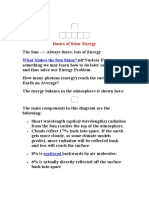How Do Solar Panel Work
How Do Solar Panel Work
Uploaded by
lambanaveen123Copyright:
Available Formats
How Do Solar Panel Work
How Do Solar Panel Work
Uploaded by
lambanaveen123Copyright
Available Formats
Share this document
Did you find this document useful?
Is this content inappropriate?
Copyright:
Available Formats
How Do Solar Panel Work
How Do Solar Panel Work
Uploaded by
lambanaveen123Copyright:
Available Formats
How Do Solar Panel Work?
A solar panel is a device that collects photons of sunlight, which are very small packets of electromagnetic radiation energy, and converts them into electrical current that can be used to power electrical loads. Using solar panels is a very practical way to produce electricity for many applications. The obvious would have to be off-grid living. Living off-grid means living in a location that is not serviced by the main electric utility grid. Remote homes and cabins benefit nicely from solar power systems. No longer is it necessary to pay huge fees for the installation of electric utility poles and cabling from the nearest main grid access point. A solar electric system is potentially less expensive and can provide power for upwards of three decades if properly maintained. Besides the fact that solar panels make it possible to live off-grid, perhaps the greatest benefit that you would enjoy from the use of solar power is that it is both a clean and a renewable source of energy. With the advent of global climate change, it has become more important that we do whatever we can to reduce the pressure on our atmosphere from the emission of greenhouse gases. Solar panels have no moving parts and require little maintenance. They are ruggedly built and last for decades when porperly maintained.Last, but not least, of the benefits of solar panels and solar power is that, once a system has paid for its initial installation costs, the electricity it produces for the remainder of the systems lifespan, which could be as much as 15-20 years depending on the quality of the system, is absolutely free! For grid-tie solar power system owners, the benefits begin from the moment the system comes online, potentially eliminating monthy electric bills or, and this is the best part, actually earning the systems owner additional income from the electric company. The solar cells you would have seen on satellites, caculaters etc are photovoltaic cells or modules (modules are a collection of solar cells electrically connected and joined together in one frame). Photovoltaics, (photo = light, voltaic = electricity), convert the energy of sunlight directly into electricity. Originally expensive and only used in space, photovoltaics are now finding many applications on countless devices, buildings etc were ever remote or free and environmentally sustainable produced electricity is required. Photovoltaic (PV) cells are made of special materials called semiconductors like silicon, which is currently the most commonly used. Basically, when light shines on the solar cell a percentage of this solar energy is absorbed into the semiconductor material. This energy now inside the semiconductor knocks electrons loose allowing them to flow freely. PV cells also all have one or more electric fields
that force electrons freed by light absorption to flow in a certain direction. This flow of electrons is an electrical current. Metal contacts on the top and bottom of the PV cell draw that current off to use to power external electrical products such as lights, calculators etc. This current ,combined with the cells voltage (which is a result of its built-in electric field or fields),determines the power (or wattage) that the solar cell can produce. Solar panels collect clean renewable energy in the form of sunlight and convert that light into electricity which can then be used to provide power for electrical loads. Solar panels are comprised of several individual solar cells which are themselves composed of layers of silicon, phosphorous (which provides the negative charge), and boron (which provides the positive charge). Solar panels absorb the photons and in doing so initiate an electric current. The resulting energy generated from photonsstriking the surface of the solar panel allows electrons to be knocked out of their atomic orbits and released into the electric field generated by the solar cells. An average home has more than enough roof area for the necessary number of solar panels to produce enough solar electricrity to supply all of its power needs. Assisted by an inverter, a device that converts the direct current (or DC current), generated by a solar panel into alternating current (or AC current), solar panel arrays can be sized to meet the most demanding electrical load requirements. The AC current can be used to power loads in your home or commercial building, your recreational vehicle or your boat (RV/Marine Solar Panels), your remote cabin or home, and remote traffic controls, telecommunications equipment, oil and gas flow monitoring, RTU, SCADA, and much more.
How to test a Solar Panel? Most in the most people that need to set up solar panels at the roof of the properties consider that all they must do is set up them, however they overlook about assessment them after which if a little something wont perform adequately they must phone for that installers once again and using this method they reduce time and get stressed. Solar panel assessment pertains to employing an amp meter at the panel. power is acknowledged for being measured in amperes. This factor may be accomplished with an amp meter. this kind of a equipment are heading to be connected towards bad and good terminals at the solar panel after which the panel are heading to be subjected towards sunlight. In purchase to guard by yourself from injuries and protected the amp meter from any destruction you really should 1st price the meter greater compared to solar panel is. The amp meter will present you on its display the brief circuit current. This are heading to be the level of electric present-day that 1 could assume out of your panels to give. OF program everything is established by how powerful was the sunshine so it can be indicted to conduct your solar panel assessment when there is ordinarily a complete sunshine outside. Besides employing an amp meter youll be in a position to decide the energy yield of your respective solar panel by employing an additional strategy that implies measuring the resistors voltage. because of this solar panel assessment process youll require a electronic multi-meter (that actions the DC voltage) and numerous resistors. subsequent to acquiring every one among the essential measurements youll be in a position to use this formulation for calculating the energy output: present-day equals Voltage / Resistance. subsequent to that 1 could constitute a overall performance graphic by plotting the energy output. You really should also be mindful that a solar panel will transform the sunshine into DC (direct current) energy not AC energy as some may perhaps expect. it is why you require for that solar panel assessment methods a DC electronic multi-meter. Watts are heading to be applied for measuring the energy the fact that solar panel produced for charging electric batteries as an example or for employing dwelling appliances. The formulation for calculating the energy is energy equals Voltage*Current. All youve still left to perform is continually to measure the amperage and voltage of your respective solar panel and plug the info to the equation. using this method youll know precisely when the solar panel are heading to be in a placement to include every one among the power you desired it to supply you once you made a decision to set up this kind of a factor on your own roof. You will even use a solar cost controller that could be designed for regulating the energy that could be brought through the solar panel towards rechargeable batteries. this kind of a controller has the intent of by-passing eventual overcharges also to present a very good power supply cost based at the
temperatures outside. apart from solar panel assessment you really should also analyze the very well working of the cost controller. If you consider youll be in a position to not conduct the solar panel assessment on your personal or you do not have time for that phone some panel installers and request them to perform this to match your needs because it may perhaps conserve you from numerous difficulty later on on.
How to Maintenance the Solar Panel? It is not uncommon for a remote site to be checked but once per year. Under most conditions, normal rainfall is sufficient to keep the Solar Panel glass clean. Clean the glass with a soft cloth using mild detergent and water. Solar Panel that are mounted, fiat ( 0tilt andle) should be cleaned more often, as they will not self-clean as effectively as Solar Panel mounted at a 15tilt or greater. It is advisable to perform periodic inspection of the Solar Panel for damage to glass, backskin, frame and support structure. Check electrical connections for loose connections and corrosion. Check if mounting support structure and modules are loose. Check connections of cables, connectors, and grounding. Change Solar Panel must be the same kind and type, if need. Solar Panel can operate effectively without ever being washed, although removal of dirt from the front glass can increase output. The glass can be washed with a wet sponge or cloth, wear rubber gloves for electrical insulation.
Solar Panel Safety precautions Solar Panel installation and operation should be performed by qualified personnel only. Children should not be allowed near the solar electric installation. Avoid electrical hazards when installing, wiring, operating and maintaining the module. Solar Panel produce DC electricity when exposed to light and therefore can produce an electrical shock or burn. Solar Panel produce voltage even when not connected to an electrical circuit or load. Solar Panel produce nearly full voltage when exposed to as little as 5% of full sunlight and both current and power increase with light intensity. Do not touch live parts of cables and connectors. As an added precaution, use insulated tools and rubber gloves when working with Solar Panel in sunlight. Fall of Solar Panel from high place will cause death, injury or damage. Do not drop Solar Panel or allow objects to fall on Solar Panel, never leave a Solar Panel unsupported or unsecured. If a module should fail, the glass can break a Solar Panel with broken glass cannot be repaired and must not be used.
When installing or working with Solar Panel or wiring, cover module face completely with opaque material to halt production of electricity. Solar Panel have no on/off switch. Solar Panel when exposed to sunlight generate high voltage and are dangerous, Solar Panel can be rendered inoperative only by removing them from sunlight, or by fully covering the front surface with opaque cloth, cardboard, or other completely opaque material, or by working with Solar Panel face down on a smooth, flat surface when installing or maintaining. Do not artificially concentrate sunlight on the Solar Panel. Solar Panel can produce higher output than the rated specifications. Industry standard ratings are made at conditions of 1000W/ and 25 cell temperature. Reflection from snow or water can increase sunlight and therefore boost current and power. In addition, colder temperatures can substantially increase voltage and power. Solar Panel are intended for use in terrestrial applications only, thus excluding aerospace or maritime conditions or use with sunlight concentration. It is recommended that the Solar Panel remains packed in the box until time of installation. Work only under dry conditions, with a dry Solar Panel and tools, since sparks may be produced, do not install Solar Panel where flammable gases or vapors are present. Do not drill holes into Solar Panel frame as it will void warranty. Solar Panel ate constructed frame as it will void warranty. Handled with care, if the front glass is broken or if the polymer backskin is tom, contact with any module surface or the frame can produce electrical shock. Particularly when the Solar Panel is wet, broken or damaged modules must be disposed of properly. Do not disassemble, bend, impact by sharp objects, walk on, and throw or drop etc. keep back surface free from foreign objects. Avoid sharp edges. Use Solar Panel for its intended function only follows all Solar Panel manufacturers instructions. Do not disassemble the module, or remove any part or label installed by the manufacturer. Do not treat the back of the Solar Panel with paint or adhesives. If not otherwise specified, it is recommended that requirements of the latest local, national or regional electrical codes be followed. Retain this installation manual for future reference. Notes The electrical characteristics are within 5 percent of the indicated values of Isc, Voc, and Pmax under standard test conditions (irradiance of 100mW/ 2, AM 1.5 spectrum, and a cell temperature of 25(77F).
Under normal conditions, a photovoltaic Solar Panel is likely to experience conditions that produce more current and/or voltage than reported at standard test conditions. Accordingly, the values of Isc and Voc marked on this module should be multiplied by a factor of 1.25 when determining component voltage ratings, conductor ampacities, fuse sizes, and size of controls connected to the PV output.
How to install and wire Solar panel? Solar panels can lower your energy costs and are rather easily installed, with a little construction and electrical knowledge. Heres how to do it. Solar panels will be the aspect of the solar power product that in fact gathers the power from your sun. The panels are developed up of photovoltaic tissue that transform the suns power to immediate existing power that is often applied for heating system or to energy appliances. The power is then sent straight to an appliance or other device, or is saved inside a power supply lender for long term use. Panels commonly measure around 1.5 ft by three feet, and can provide about 75 watts of power if situated in total sun. Typically the panels are installed around the roof of the building. However, they is often installed over a stand-alone rack if necessary. one of the most crucial thing to consider is just how much sunshine the panel are certain to get while in the area you choose. Solar panels drop effectiveness easily in even a partially shaded location, so go with a area that receives total sunshine for as prolonged as achievable each and every day. The panels ought to be oriented for the to the south if whatsoever possible. The 2nd most effective preference would be to deal with the panels for the west or east, but you are heading to have to take advantage of additional panels in purchase to acquire identical level of energy. never ever deal with the panels for the north. Be positive to acquire any important setting up permits just before setting up the panels. examine together with your community setting up or zoning department to locate out what are the needs are with your community. if you occur to dont have the permits just before the set up or dont total the set up in accordance with community setting up codes, you may likely be forced to tear out all of your very hard operate and commence again. The panels ought to be tilted to attain the optimum level of sun. The stage of tilt is dependent around the latitude at which they may be installed. Panels set up at 0 to 15 degrees latitude really should have a very 15-degree tilt. Panels set up at 15 to twenty five degrees latitude really should have a very tilt that could be the very same since the latitude. For each and every supplemental 5 degrees of latitude as much as 40 degrees, include an added five degrees of tilt for the latitude. At latitudes of 40 degrees and above, include twenty degrees of tilt for the latitude. Mounts ought to be inserted about 48 inches aside and ought to be situated straight on major of the rafter, if whatsoever possible. If a rafter just isnt accessible with the mount site, the mount is often connected to some prevent of wooden inserted around the underside for this roof. dont attach the mount straight for the plywood sheathing for this roof. locate rafters using a stud finder. preserve the mounts inside a right line, utilizing a laser beam sight or probably a chalk line. Drill a hole using a pilot little bit to insure that which you dont separation the rafter. Then protected the bottom for this mounts for the roof, utilizing stainless metal lag bolts. Thread the submit for this mount into its base. make positive to spot roof flashing throughout each and every mount to avoid leaks while in the roof. up coming fasten steel rails for the mounts with stainless metal bolts. total the racking product by connecting aluminum solar racks for the steel rails. Make positive how the finished rack product will grant the solar panels being no much less than 3 to 6 inches away the roof. The panels will run additional effectively if theres sufficient airflow below and close to them.
Solar panels may likely be preassembled in groups. This can make the set up less complicated and quicker, as there are actually much less person models to cope with up around the roof. protected the solar panels for the racking product while using restraining hardware provided while using panels. each and every maker has their individual hardware, particularly constructed for his or her individual panels. analyze the panels to produce positive that they may be anchored securely. Make positive how the together the solar panel and also the racking methods are effectively grounded in accordance while using community electric codes. Interconnect the solar panels by starting the junction penalty area around the back again of each and every panel and attaching the wires for the correct good and unfavorable terminal screws while in the box, getting clear of one-half inch of insulation from your finishes for this wires first. The wire will operate involving panels as a result of the knockouts in each and every box. operate the wire from your last panel to some distinct array junction box. The wire is then operate as a result of electric conduit for the up coming electric aspect for this system, this type of since the cost controller. near all junction boxes. Your solar panel array really should grant *you several many years of satisfying service.
What is Difference between monocrystalline polycrystalline and Amorphous thin film solar cell?
1. Difference between crystalline and amorphous? Daily to see the solid is divided into two major categories of non-crystalline and crystalline, non-crystalline arrangement of atoms within the material is not necessarily the law of the fracture when the fracture is random, such as plastic and glass, and called the crystal material, represent the natural shape of a regular polyhedron, with obvious edges and corners with the plane, the atom is in accordance with its internal law must line up neatly, so when they break off the plane according to certain, such as salt, crystal and so on. 2. Difference between monocrystallie and polycrystalline? Some of the crystal is composed of many small grains, if the arrangement between the grains are no rules, this is called polycrystalline crystal, such as copper and iron. But there are also the crystal itself is a complete large grains, the crystal is called single crystal, crystal and crystal diamond. 3. Monocrystalline silicon and polycrystalline silicon photovoltaic cells compare? Monocrystalline silicon cells with a cell conversion efficiency, good stability, but the cost is high. Low-cost polycrystalline silicon cells, the conversion efficiency slightly lower than the Czochralski silicon solar cells and materials in a variety of defects such as grain boundaries, dislocations, micro-defects, and material impurities carbon and oxygen, as well as the stained process transition metals. The first is the advent of solar cell silicon solar cells. Silicon is very abundant on the earth, an element almost everywhere have the presence of silicon can be said to be used without silicon to make solar cells, indeed no shortage of raw materials. But it is not easy to extract, so people in the production of monocrystalline silicon solar cells, they also studied the polycrystalline silicon solar cells and amorphous silicon solar cells, has commercial-scale production of solar panel, also did not jump out of silicon series. In fact, the semiconductor materials for manufacture of solar cells a lot, along with the development of industrial materials, solar cells will be more and more varieties. Research and trial production has been the solar cell, in addition to silicon series, there are cadmium sulfide, gallium arsenide, copper indium selenium and many other types of solar cells, too numerous to mention, the following are a few of the more common solar cells. Monocrystalline silicon solar cells Monocrystalline silicon solar cells is currently the fastest developing a solar cell, its composition and production technology has been finalized, the products have been widely used for space and ground facilities. The high purity single crystal silicon solar cells as the raw material rod, 99.999% purity. In order to reduce production costs, and now solar terrestrial applications such as the use of solar-grade
silicon rods, material performance has been relaxed. Some semiconductor devices can also be used for processing materials and discard ends of silicon materials, solar cells made by re-drawing a dedicated silicon rods. The slice of silicon rods, generally 0.3 mm thick slices. Wafer after forming, polishing, cleaning and other processes, made of silicon raw material to be processed. Solar cell processing chip, the first doping and diffusion in silicon, usually for the small amount of boron dopant, phosphorus, antimony and so on. Diffusion is the control into the quartz furnace for high temperature diffusion. And then using screen printing will be printed with a good paste made of silicon gate line, after sintering, also made of the back electrode and a gate line in the face of anti-reflection coating source, to prevent a large number of photons reflected from a smooth silicon surface, thus, single-chip silicon solar cells are produced. After single-chip random testing, according to the required specifications can be assembled into solar modules (solar panels), the method used in series and parallel to a certain output voltage and current, and finally with the framework and package materials package. According to the system user can design different size solar module solar cell composed of a variety of square, also known as the solar array. Current silicon photoelectric conversion efficiency of solar cells is about 15%, laboratory results have more than 20%. Also for the space station up to 50% or more solar panels. Polycrystalline silicon solar cells Monocrystalline silicon solar cell production requires large amounts of high-purity silicon material, the production of these materials, process complexity, power consumption drastically, the total cost of solar cell production has been over half, combined with the silicon rod was drawn cylindrical, sliced wafer production solar cells is to form a solar module surface low utilization rate. Thus, 80 years, some European and American countries, the development into a polycrystalline silicon solar cells. Polycrystalline silicon solar cells using current materials, mostly a collection contains a lot of single crystal particles, or silicon materials from waste materials and metallurgical grade silicon melt molded. The process is to select a resistivity of 100 to 300 ohms? Cm block of material or a polycrystalline silicon material end to end, after crushing, with the 1:5 mixture of hydrofluoric acid and nitric acid corrosion appropriate, and then spent neutral-ionized water rinse and drying. Quartz crucible installed polysilicon materials, the addition of appropriate amount of boron in silicon, release the casting furnace, heating and melting in a vacuum state. Melted insulation should be about 20 minutes, and then injected into the graphite mold, to be cooled slowly solidified, that have polysilicon ingot. The ingots can be cast cubes to be processed into square slices film solar cells can improve material utilization and easy assembly. Polycrystalline silicon solar cells and solar cell production process is similar to the photoelectric conversion efficiency of about 12%, slightly lower than the silicon solar cells, but the material is simple, to save power consumption, the total production costs low, so get a lot of development. As the technology was improved, the current conversion efficiency of polycrystalline silicon can also be reached around 14%. Amorphous silicon solar cells Amorphous silicon solar cells appeared in 1976 with a new thin film solar cells, monocrystalline and polycrystalline silicon solar cells it with the production method is completely different, very little silicon material consumption, lower power consumption, very attractive. Method of manufacturing a variety of amorphous silicon solar cells, the most common is the glow discharge method, as well as reactive sputtering, chemical vapor deposition, electron beam evaporation and thermal decomposition of silane method. Glow discharge method is a Dan Yingrong device pumped into vacuum, hydrogen or argon gas filled diluted silane, with the RF power heating, ionization of silane to form a plasma. Deposition of amorphous silicon film on the substrate being heated. If the silane were mixed in the amount of hydrogenated or hydrogenated boron phosphate can be N-or P-type amorphous silicon film. Substrate materials are generally made of glass or stainless steel. Preparation of amorphous silicon thin film technology which depends mainly on the strict control of pressure, flow rate and RF power, the temperature of the substrate is also very important. The structure of amorphous silicon solar cells there are different, which has a structure called the PiN better battery, it is first deposited on the substrate N-type layer of amorphous silicon doped with phosphorus, and then deposited a layer of
undoped i layer, and then deposited a layer of P-type boron-doped amorphous silicon, and finally a layer of electron beam evaporation of antireflection coatings, and deposition of silver electrodes. This production process, a series of deposition chamber can be used in production form a continuous process to achieve mass production. Meanwhile, the thin amorphous silicon solar cells can be made into laminated type, or use to manufacture integrated circuits in a plane, with the appropriate mask technology, a production of multiple batteries in series to obtain higher voltage . Because the average crystalline silicon solar cells around a single voltage of 0.5 volts, and now the production of amorphous silicon tandem solar cells in Japan up to 2.4 volts. The current problem is that of amorphous silicon solar cell conversion efficiency is low, the international advanced level of about 10%, and is not stable enough, often decline down conversion efficiency of the phenomenon, so not a lot of use for largescale solar power, but mostly with in low light power, such as pocket electronic calculators, electronic watches and clocks and copier and so on. Failure to overcome the drop in efficiency issues, the amorphous silicon solar cells will promote the great development of solar energy, because its low cost, light weight, easier application, it can be combined with the housing of the roof form independent power of households. In the fierce sun, single crystal solar panels can be transformed more and more non-crystal-type solar energy to electricity more than doubled, but unfortunately, the price of single crystal type of noncrystal-like than the two or three times more expensive, and in the case of non-cloudy Instead, the crystal-type transistor can be almost as much to collect solar energy.
Solar Panel Mounting
For home solar arrays, we generally recommend mounting solar panels at the top of a sturdy pole. This is called a pole top mount. They are easy to install. They keep the panels off the ground and out of harms way but are easy to adjust and to reach for snow removal. Yes, when the snow stops falling and the sun comes back out, you want to be able to sweep the snow off those panels. So think about where you place them, how far they are from the house, and how high up they are. A pole top mount can be either fixed, which means it holds the panel stationary, or it can move, or track, with the sun. A solar panel mount that allows the panel to move with the sun is called a tracker. Fixed Racks can include Ground Mounting, Roof Mounting, Pole-Side Mounting, Boat/RV Mounts, as well as Pole Top Mounting. All trackers are mounted on poles, and so are technically pole top mounts. The pole of a pole top mount must be anchored in the ground by digging a hole and filling it with concrete. The size of hole in diameter is usually 18 inches to 2 feet (18 inches plus the diameter of the pole). The depth of the hole must be 1/2 of the height of the pole above ground. If the pole will be 7 feet above ground, you have to dig a 3 1/2 foot hole. The placement of your solar panels, whatever kind of mounting system you are using, can make a huge difference in the amount of electricity you are able to produce. Be very careful not to place your panels in an area that is shaded by trees or buildings or any other object. Note carefully that the shadow made by your house moves at least 22 feet farther to the south in the winter. If you place your panels within that distance, youll be very disappointed during those short winter days.
We have three types solar panel mounting: Pitch Roof mounting look neat, but are hard to reach to adjust the angle. Will you want to walk across your roof several times a year to adjust the angle? Does it snow often? Will you have to walk across a slippery roof to sweep snow off the panels? Is the slope of the roof you want to use good for optimum solar panel efficiency or will you need tilt legs to face your panels more perpendicular to the sun? Pole Mounting are designed to hold 1 to 4 modules and are mounted to the pole with either hose clamps or U-bolts (not provided). The racks accommodate different sized poles and are adjustable for optimal sun angle from 15 to 65 degrees in 10-degree increments. Pole size is determined by the number of modules to be mounted. Ground Mounting are probably the easiest way to mount solar panels. This mount resembles an Aframe. It safest to attach this structure to a cement slab so that it may be secured in place. Ground mounts are designed to handle from 1 to 8 solar modules. Ground mounts can be used to attach solar panels to the ground, to a roof and or to a vertical surface. Some ground mounts have tiltable, or adjustable legs; others are fixed. Optional adjustable tilt legs are available for several of the styles of panels Wholesale Solar sells.
: Pitch roof solar mounting
Rooftop solar mounting system apply for all kinds of pitch roof of any building. Solar panel can fastened onto the top flute of our patented solar mounting rail. L-feet connects with the bottom of the rail, which mounted firmly to the roof. Install flashing over a layer of shingles to insure water resistance. A single wrench is enough for the installation procedures. Detailed installation manual ensure an easy and smooth installation.
Specification: Design Wind Load: 55m/s or 200km/hour Design Snow Load: 1.5kn/m2 Steel structure: Anodized Aluminum + Stainless Steel reference standard: AS/NZ 1170.2 Installation site:Pitch root Guarantee: Ten years guarantee on parts
1.We use L-feet for tin roof and hook for tile-roof to connect the rack structure with the rafters of the roof. 2.At the installation site we do not require welding, and even have no need to drill a hole, just using the electrical locks and wrenches and other simple tools to complete the installation. This simplify the traditional installation procedure, we will manage to preassemble the screws and nuts before shipment to reduce on-site installation procedures and labor intensity. Eliminate the differences in degree of on-site professional installation and degree of impact on the quality of the roof support system. 3.Utilization of the anodized aluminum, stainless steel, anti-aging UV process to ensure the longer life span of our solar technology and solar tracking.
: Ground Solar Panel Mounting:
Ground Solar Panel Mounting is suitable for flat roofs of various structures or for the ground. One end of the cross-beam is connected firmly with the ground structure by base bracket and hex-bolts and the another end is connected to the support leg forming a stable and strong tripod structure. The connecting foot is made up of stainless steel to enhance the load bearing capacity. Stainless steel itself has a good physical and chemical mechanical performance, service life can reach more than 30 years.
Specification: Design Wind Load 55m/s or 200km/hour Design Snow Load 1.5kn/m2 Steel structure: Anodized Aluminum + Stainless Steel Reference standard: AS/NZ 1170.2 Installation site: Flat roop or Ground Guarantee: Ten years guarantee on parts
: Pole Solar Panel Mounting
Pole system is designed for up to 1.5kw panel mounting system, with the wind load up to 200km/h. This panel mounting system is suited for large photovoltaic system installation in all wind zones. This solar mounting system can adjust the tilt angle according to the requirement of the installation place. There is no need to welding in the complete installation process. According to our manual instruction, you can install the solar modules easily, quickly, securely and cost efficiently.
Specification: Design Wind Load 55m/s Design Snow Load 1.5kn/m2 Steel structure Hot dipped galvanized steel + Anodized Aluminum Reference standard AS/NZ 1170.2 Tracker type Fixed Tilt angle 0 60 Guarantee Ten years guarantee on parts
1. Convenient and quick installation. The use of bolted connections eliminates drilling and welding process automatically reducing the operating time. 2. Mounting rack structure uses hot dip galvanized steel parts which gives a good external appearance(silvery white) and also has good corrosion resistance.Under natural conditions, it can be used for 20-30 years. 3. Batteries components are made up of aluminum alloy treated with anode oxidation process which makes the appearance of smooth and bright. Since this material is same as panel frame, it can decrease metal corrosion phenomena mutually. 4 Holding component( bolts ,screws) are made of stainless steel bolts, stainless steel itself has a good physical and chemical mechanical properties, its service life span can reach more than 30 years.
Ground Solar Panel Mounting System
Ground Solar Panel Mounting System For Safe Installation Work This manual contains critical information regarding electrical and mechanical installation and safety information which you should know before starting installation. CAUTIONS REGARDING INSTALLATION OF GRACESOLAR Stop working duringunder storms, typhoons, hurricanes, earthquakes, volcanic eruptions and other adverse weather and natural disaster situations. Never step or sit on the glass surface of a solar module. The glass may break, resulting in shock or bodily injury. The module may also stop generating power. Please strictly abide by height safety regulation in high-attitude operation Please strictly abide by live working safety norms in line operation Please strictly abide by heat work safety regulation in heat work operation Always use the specified tools. The solar modules or mounts may fall if the installation is not strong enough, for example when parts are not tightened sufficiently. Please strictly in accordance with the requirements of this manual for installation. Installation Steps Fix the pole as demonstrated. Install the main beam by 30 Pin. Install the adjustable part by 20pin(Picture 4) One end attached to pole, the other end attached to main beam. Place the supporting beam on the main beam, fix it with M8 hex screws. Install the 4040 conjunctions. With M8 screw go in through the hole on the supporting beam. Install all the conjunctions in this way. Keep all the conjunction face one side Place the rails on the supporting beam. The rail is attached to the conjunction. Note Rails connected by splice kit.
Place the first module of the bottom row. Slide the end clamp tightly against the solar panel and fasten it. Note
The rail should leave a space of 25mm-30mm
Slide the next module against the installed module. Fasten the mid clamp. Install other modules and clamps in this way. Keep module even. The angel could be adjustable by the adjustable parts by changing its position to the main beam.
Pole Top Solar Panel Mounting System
Pole Top Solar Panel Mounting System This manual contains critical information regarding electrical and mechanical installation and safety information which you should know before starting installation. CAUTIONS REGARDING GRACESOLAR INSTALLATION OF
Stop work during stormy weather. Solar modules can be caught in the wind, causing you to fall. Never step or sit on the glass surface of a solar panel. The glass may break, resulting in shock or bodily injury. The module may also stop generating power. Always use the supplied parts to attach the solar modules and mounts. Use of weaker parts, such as screws that are too short, is dangerous and may cause the solar modules or mounts to fall. Always use the specified tools. The solar modules or mounts may fall if the installation is not strong enough, for example when parts are not tightened sufficiently. Do not modify or cut parts. Doing so is dangerous. Safety cannot be guaranteed. Product should be installed and maintained by qualified personnel. Keep unauthorized personnel away from solar modules
Installation Steps Determine the position of leg positions in the beginning. The distance between each leg pair L1 equals to the length of Supporting Pipe Installation of the angle iron onto the legs. Put Supporting Pipe onto the front leg/rear leg, Fixed it with U-bolts. Firstly put rails on the supporting pipe. Note: the position of the rails. Installation of the splice to connect multiple rails together. Slide the splice on the rear side of the pre-assembled rails. Fasten the first bolt firmly. Then slide the next rail into the splice. Installation of the rails. Fix the rail with U bolt kit. Install all the rails onto the supporting pipe. Place the first module of the bottom row. Slide the end clamp tightly against the module and fasten it. Install the end clamp and mid clamps.
The edge of solar panel to the rail distance: 25mm-30mm Installation of the clamps
Slide the next module against the installed module. Fasten the mid clamp. Install other modules and clamps in this way. Keep module even. Install all the panels. Finished.
Pitched Roof Racking Solar Panel Mounting System Installation Manual For Safe Pitched Roof Racking Solar Panel Mounting System Installation Work This manual contains critical information regarding electrical and mechanical installation and safety information which you should know before starting installation. CAUTIONS REGARDING INSTALLATION OF GRACESOLAR Stop work during stormy weather. Solar panel can be caught in the wind, causing you to fall. Never step or sit on the glass surface of a solar module. The glass may break, resulting in shock or bodily injury. The module may also stop generating power. Always use the supplied parts to attach the solar modules and mounts. Use of weaker parts, such as screws that are too short, is dangerous and may cause the solar modules or mounts to fall. Always use the specified tools. The solar modules or mounts may fall if the installation is not strong enough, for example when parts are not tightened sufficiently. Do not modify or cut parts. Doing so is dangerous. Safety cannot be guaranteed. Product should be installed and maintained by qualified personnel. Keep unauthorized personnel away from solar modules
POINTS TO CHECK Determine the wind loads for the installation site. Check with your local building and safety department for the specific requirements. Make certain that the roof structure can support the live and dead loads resulting from the installation of the PV array. Install solar modules facing south, if possible. Installations facing east and west are also possible, although the amount of power generated will be lower. Installation Steps Determine the position of the roof hooks according to your design. The roof hook must not press against the roof tile. Place it flat. If necessary, shim the roof hook with wood. If necessary, use an angle grinder or hammer to cut a concavity in the tile that covers the roof hook at the point where the roof hook comes through. (Caution! Must not use fixed roof hook as a ladder, as this extreme point load could damage the tile below. Installation of the rails on roof hooks. Your rails consist of different length, always begin with the shortest piece. Install the rails on the roof hooks loosely at first, using T-screw. Installation of Clamps
Installation of the splice to connect multiple rails together. Slide the splice on the rear side of the preassembled rails. Fasten the first bolt firmly. Then slide the next rail into the splice. When comes together, fasten the other bolt. The connection is finished. An expansion gap at the rail joints is suggested. Leave a gap about a finger width. Place the first module of the bottom row. Slide the end clamp tightly against the module and fasten it. Install the end clamp and mid clamps. Clamp Installation Slide the next module against the installed module. Fasten the mid clamp. Install other modules and clamps in this way. Keep module even.
Solar Charge Controller
We offer high quality and cheap price PWM Solar Charge Controller and MPPT Solar Charge Controller. There has JUTA, EP and Cinco series Solar Charge Controller.Such As, CMP12, CM3024Z, CM5024Z, MPPT-10,MPPT-20, MPPT30, EP solar controller LandStar, SeaStar and ViewStar, And Tracker MPPT Solar Controller.all above types solar controller are widely sell over 50 countries.
How do the Solar Charge Controller Work?
A Solar charge controller, or solar regulator is similar to the voltage regulator in your car. It regulates the voltage and current coming from the solar panels going to the battery. Most 12 volt panels put out about 16 to 20 volts, so if there is no regulation the batteries will be damaged from overcharging. Most batteries need around 14 to 14.5 volts to get fully charged. Not always, but usually. Generally, there is no need for a Solar charge Controller with the small maintenance, or trickle charge panels, such as the 1 to 5 watt solar panels. A rough rule is that if the panel puts out about 2 watts or less for each 50 battery amp-hours, then you dont need one. For example, a standard flooded golf car battery is around 210 amp-hours. So to keep up a series pair of them (12 volts) just for maintenance or storage, you would want a panel that is around 4.2 watts. The popular 5 watt panels are close enough, and will not need a controller. If you are maintaining AGM deep cycle batteries, such as the Concorde Sun Xtender then you can use a smaller 2 to 2 watt panel. What is the different from PWM and MPPT Solar Charge Controller? PWM Solar Charge Controller:
Quite a few charge controls have a PWM mode. PWM stands for Pulse Width Modulation. PWM is often used as one method of float charging. Instead of a steady output from the controller, it sends out a series of short charging pulses to the battery a very rapid on-off switch. The controller constantly checks the state of the battery to determine how fast to send pulses, and how long (wide) the pulses will be. In a fully charged battery with no load, it may just tick every few seconds and send a short pulse to the battery. In a discharged battery, the pulses would be very long and almost continuous, or
the controller may go into full on mode. The controller checks the state of charge on the battery between pulses and adjusts itself each time. MPPT Solar Charge Controller:
MPPT solar charge controller schematic, A maximum power point tracker (or MPPT) is a high efficiency DC to DC converter which functions as an optimal electrical load for a photovoltaic (PV) cell, most commonly for a solar panel or array, and converts the power to a voltage or current level which is more suitable to whatever load the system is designed to drive. The most basic solar charge controller simply monitors the battery voltage and opens the circuit, stopping the charging, when the battery voltage rises to a certain level. Older charge controllers used a mechanical relay to open or close the circuit, stopping or starting power going to the batteries. More modern charge controllers use pulse width modulation (PWM) to slowly lower the amount of power applied to the batteries as the batteries get closer and closer to fully charged. This type of controller allows the batteries to be more fully charged with less stress on the battery, extending battery life. It can also keep batteries in a fully charged state (called float) indefinitely. PWM is more complex, but doesnt have any mechanical connections to break. The most recent and best type of solar charge controller is called maximum power point tracking or MPPT. MPPT solar controllers are basically able to convert excess voltage into amperage. This has advantages in a couple of different areas. Most solar power systems use 12 volt batteries, like you find in cars. (Some use other voltages and the same advantages apply to these systems as well.) Solar panels can deliver far more voltage than is required to charge the batteries. By, in essence, converting the excess voltage into amps, the charge voltage can be kept at an optimal level while the time required to fully charge the batteries is reduced. This allows the solar power system to operate optimally at all times. Another area that is enhanced by an MPPT charge controller is power loss. Lower voltage in the wires running from the solar panels to the charge controller results in higher energy loss in the wires than higher voltage. With a PWM charge controller used with 12v batteries, the voltage from the solar panel to the charge controller typically has to be 18v. Using an MPPT controller allows much higher voltages in the wires from the panels to the solar charge controller. The MPPT controller then converts the excess voltage into additional amps. By running higher voltage in the wires from the solar panels to the charge controller, power loss in the wires is reduced significantly. MPPT charge controllers are more expensive that PWM charge controllers, but the advantages are worth the cost. If you can afford it, you should definitely use an MPPT solar charge controller. The final function of modern solar charge controllers is preventing reverse-current flow. At night, when solar panels arent generating electricity, electricity can actually flow backwards from the batteries through the solar panels, draining the batteries. Youve worked hard all day using solar power to charge the batteries, you dont want to waste all that power! The charge controller can detect when no energy is coming from the solar panels and open the circuit, disconnecting the solar panels from the batteries and stopping reverse current flow.
: JUTA Series Solar Charge Controller
Model No CMP 3A CMP 6A CMP 10A CMP 12A CM3024Z CM5024Z MPPT-05 MPPT-10 MPPT-20 MPPT-30 Max Load Current 1A or 3A 6A 10A 12A 30A 50A 5A 10A 20A 30A Output Volatge 6V or 12V 12V 24V Auto Switch 12V 24V Auto Switch 12V 24V Auto Switch 12V 24V Auto or 48V 12V 24V Auto or 48V 12V or 24V 12V or 24V or 48V 12V or 24V or 48V 24V Work Model PWM PWM PWM PWM PWM PWM MPPT MPPT MPPT MPPT Application Solar Lamp Solar System Solar System Solar System Solar System Solar System Solar Lamp Solar System Solar System Solar System LCD LCD Light and timer Sensor LCD LCD LCD Other Information Light and timer Sensor
: EP Series Solar Charge Controller
Model No EPRC10ST EPRC10MF Max Load Current 5A,10A Output Volatge Work Model PWM Application Other Information
12V 24V Auto Switch
Solar Lamp
Light and Timer Sensor
10A
12V 24V Auto Switch 12V 24V Auto Switch 12V 24V Auto Switch 12V 24V Auto Switch 12V 24V Auto Switch 12V 24V Auto Switch
PWM PWM PWM PWM PWM PWM PWM PWM PWM
Solar Lamp Solar Lamp Solar Lamp Solar System Solar System
Light and Timer Sensor,Waterproof Light and Timer Sensor,Two Load Light,timer,Dual Battery,Meter
EPIP20-2L 15A,20A EPIP20-DB 10A,20A EPHC10ST 5A,10A
EPIP20-H 15A,20A EPIP30 EPIP602 EPIP603 IPS48 20A,30A
Solar System LCD display Solar System LCD display Solar System LCD display Solar System LCD display
30A,40A,50A,60A 12V 24V, 24V 48V Auto 30A,40A,50A,60A 12V 24V, 24V 48V Auto 100A,200A 48V
NEW EP Series Solar Charge Controller
Model No
Max Load Output Volatge Current 12V 24V Auto Switch 12V 24V Auto Switch 12V 24V Auto Switch 12V 24V Auto Switch 12V 24V Auto Switch 12V 24V Auto Switch 12V 24V Auto Switch 12V 24V Auto Switch 12V 24V Auto Switch 12V 24V Auto Switch 12V 24V Auto Switch 12V 24V Auto Switch 12V 24V Auto Switch 12V 24V Auto Switch 12V 24V Auto Switch 12V 24V Auto Switch
Work Application Model MPPT Solar System MPPT Solar System MPPT Solar System PWM PWM PWM PWM PWM PWM PWM PWM PWM PWM PWM PWM PWM Solar System Solar System Solar System Solar System Solar Lamp Solar Lamp Solar Lamp Solar Lamp Solar Lamp Solar Lamp Solar Lamp Solar Lamp Solar Lamp
Other Information 1206 60V/1210 100V/1215 150V 1206 60V/1210 100V/1215 150V 1206 60V/1210 100V/1215 150V
Tracer 10A 10A Tracer 20A 20A Tracer 40A 40A LS0524 LS1024 LS1524 LS2024 LS0524R LS1024R LS1524R LS2024R LS1024RD LS1524RD LS2024RD LS1024RP LS1524RP 5A 10A 15A 20A 5A 10A 15A 20A 10A 15A 20A 10A 15A
Light and Timer Sensor Light and Timer Sensor Light and Timer Sensor Light and Timer Sensor Light and Timer Sensor,dual Load Light and Timer Sensor,dual Load Light and Timer Sensor,dual Load Light,Timer Sensor,Waterproof Light,Timer Sensor,Waterproof
LS2024RP
20A
12V 24V Auto Switch 12V 24V Auto Switch 12V 24V Auto Switch 12V 24V Auto Switch 12V 24V Auto Switch 12V 24V Auto Switch 12V 24V Auto Switch 12V 24V Auto Switch 12V 24V Auto Switch 12V 24V Auto Switch 12V 24V Auto Switch 12V 24V Auto Switch 12V 24V Auto Switch 12V 24V Auto Switch 12V 24V 36V 48V Auto
PWM PWM PWM PWM PWM PWM PWM PWM PWM PWM PWM PWM PWM PWM PWM
Solar Lamp Solar Lamp Solar Lamp Solar Lamp Solar System Solar System Solar System Solar System Solar System Solar System Solar Lamp Solar Lamp Solar Lamp Solar System Solar System
Light,Timer Sensor,Waterproof Light,Timer,Waterproof,Dual Load Light,Timer,Waterproof,Dual Load Light,Timer,Waterproof,Dual Load Surface mounting Surface mounting Surface mounting Aluminum case,Moisture Proof Aluminum case,Moisture Proof Aluminum case,Moisture Proof Light and Timer Sensor,Moisture Proof Light and Timer Sensor,Moisture Proof Light and Timer Sensor,Moisture Proof LCD Display LCD Display
LS1024RPD 10A LS1524RPD 15A LS2024RPD 20A LS1024S LS1524S LS2024S SS1024 SS1524 SS2024 SS1024R SS1524R SS2024R VS-24V VS-48V 10A 15A 20A 10A 15A 20A 10A 15A 20A 10A-60A 10A-60A
What is Solar Charge Controller?
What is Solar Charge Controller? A Solar Charge Controller (also known as a charge controller) is used in conjunction with a stand alone (off grid) system, or a grid connect solar power system that incorporates a backup battery bank. For a grid connect solar power system that doesnt use batteries, a Solar Charge Controller is not needed. A Solar Charge Controller is a small box consisting of solid state circuitry which is placed between a solar panel and a battery. Its function is to regulate the amount of charge coming from the panel that flows into the deep cycle battery bank in order to avoid the batteries being overcharged. A regulator can also provide a direct connection to appliances, while continuing to recharge the battery; i.e. you can run appliances directly from it, bypassing the battery bank; but the batteries will continue to be charged.Modern Solar Charge Controllers are very efficient and will outperform just about any 3 stage mains power battery charger. How to Choose Solar Charge Controller? To determine the size regulator youll require, check the amp ratings of your solar panels and add those figures up and that will give you the minimum size regulator youll need or you can use our system builder tool which will tell you the size youll need based on various selections. When selecting a Solar Charge Controller, its important to also look ahead if you think youll be adding to your system, it pays to buy a regulator rated as high as possible, which can save you money when you add additional solar panels. Some Solar Charge Controllers include a Low Voltage Disconnect (LVD) feature. This monitors the battery level and will disconnect any load connected to the battery if the voltage drops to a point where continued draw can cause permanent battery damage. This feature is a great protection for your deep cycle battery investment as a battery that has been discharged too deeply will have a far shorter serviceable life. How to maintenance Solar Charge Controller? A Solar Charge Controller requires no maintenance aside from regular checks of the wired in connections to see that they are tight and corrosion free. A Solar Charge Controller should be mounted out of direct sunlight and in an area where there is decent air flow. While the Solar Charge Controllers of today are extremely robust; performance and serviceable life will suffer in extreme heat. As an additional safety mechanism to protect the regulator, your batteries and appliances, plus reduce fire risk, its wise to place an appropriately rated fuse between the solar panel and the regulator.
What is MPPT Solar Controller? What is MPPT Meaning ? MPPT meaning:MPPT Meaning maximum power point MPPT Meaning maximum power point tracker is a high efficiency DC to DC converter that presents an optimal electrical load to a solar panel or array and produces a voltage suitable for the load.most commonly for a solar panel or array, and converts the power to a voltage or current level which is more suitable to whatever load the system is designed to drive. Panel tracking this is where the solar panels are on a mount that follows the sun. The most common are the Zomeworks and Wattsun. These optimize output by following the sun across the sky for maximum sunlight. These typically give you about a 15% increase in winter and up to a 35% increase in summer. This is just the opposite of the seasonal variation for MPPT Solar Controller. Since panel temperatures are much lower in winter, they put out more power. And winter is usually when you need the most power from your solar panels due to shorter days. Maximum Power Point Tracking is electronic tracking usually digital. The charge controller looks at the output of the solar panel, and compares it to the battery voltage. It then figures out what is the best power that the panel can put out to charge the battery. It takes this and converts it to best voltage to get maximum AMPS into the battery. (Remember, it is Amps into the battery that counts). Most modern MPPTs are around 93-97% efficient in the conversion. You typically get a 20 to 45% power gain in winter and 10-15% in summer. Actual gain can vary widely depending weather, temperature, battery state of charge, and other factors. Grid tie systems are becoming more popular as the price of solar drops and electric rates go up. There are several brands of grid-tie only (that is, no battery) inverters available. All of these have built in MPPT. Efficiency is around 94% to 97% for the MPPT conversion on those.
What Advantage of MPPT solar controller? In any applications which PV module is energy source, MPPT solar controller is used to correct for detecting the variations in the current-voltage characteristics of solar cell and shown by I-V curve. MPPT solar controller is necessary for any solar power systems need to extract maximum power from PV module; it forces PV module to operate at voltage close to maximum power point to draw maximum available power. MPPT solar controller allows users to use PV module with a higher voltage output than operating voltage of battery system.For example, if PV module has to be placed far away from charge controller and battery, its wire size must be very large to reduce voltage drop. With a MPPT solar controller, users can wire PV module for 24 or 48 V (depending on charge controller and PV modules) and bring power into 12 or 24 V battery system. This means it reduces the wire size needed while retaining full output of PV module. MPPT solar controller reduces complexity of system while output of system is high efficiency. Additionally, it can be applied to use with more energy sources. Since PV output power is used to control DC-DC converter directly. MPPT solar controller can be applied to other renewable energy sources such as small water turbines, wind-power turbines, etc. Compare to the PMW solar controller: The most PWM Solar controller simply monitors the battery voltage and opens the circuit, stopping the charging, when the battery voltage rises to a certain level. Older charge controllers used a mechanical relay to open or close the circuit, stopping or starting power going to the batteries.Traditional Solar Inverters perform MPPT for an entire array as a whole. In such systems the same current, dictated by the inverter, flows though all panels in the string. But because different panels have different IV curves, i.e. different MPPs this architecture means some panels will be performing below their MPPT, resulting in the loss of energy.
How Do Solar Street Light Work? The solar street lights work on the principle of the photovoltaic cell or solar cell. The solar cell converts solar energy to the electrical energy which is stored in the battery. The solar lamp draws the current from this battery and it requires no other wiring. The solar street lights use solar energy, a form of the renewable energy. These days it is common to see the solar street lamps along the sides of roads. The solar street lights comprise of the photovoltaic cells, which absorb the solar energy during daytime. The photovoltaic cells convert solar energy into electrical energy, which is stored in the battery. At the nighttime the lamp starts automatically and it consumes the electricity already stored in the battery. During the day time the battery gets recharged and the process keeps on repeating every day. Models of Solar Street Lights 1) Sodium Vapor Lights: The sodium street lights use sodium in excited state to discharge the light. These lights comprise of the solar panels that absorb the solar energy during daytime, which is converted into electricity and stored in the batteries. At nighttime the sodium lamps consume electricity from rechargeable battery. There is no wiring required for these lamps, there are no electricity bills to be paid, they are very safe and can light the streets from 4 to 12 hours depending on the size of the solar panels and battery. The sodium solar street lights can be used for lighting streets, public places, residential areas, parks, plaza etc. 2) Solar LED lights: LED stands for light emitting diode. LED comprises of the chemical compound that gives of the light when direct current (DC) from the battery passes through it. Solar LEDs are available from number of companies in different sizes, shapes and styles. The life of LED is usually very high extending up to 50,000 hours. The LEDs require very little current hence the solar panels of smaller sizes are required for the solar lights with LED lamps. 3) Solar Light Controller : Solar lights using induction technology: In this technique the lamps used in the solar lights do not contain the filament or the electrodes that tend to get damaged faster, thus ensuring very high life of the lamp. The life of the lamp in solar street lights based on induction technology can be more than 10, 0000 hours, which is almost 100 times the life of the incandescent lamps. These results in lower maintenance and electrical costs and fewer disturbances caused to the traffic on the road. Since these lights are based in induction technology, they generate lesser heat, thus permitting the use of aluminum reflectors that increases the intensity of the light produced by the lamp.
Solar Street Light Install User Manual 1. knowleage solar street light solar street light components and working principle Solar street light was composed mainly by solar module, intelligent controller, maintenance-free batteries, light source, such as light poles and structural components. The working principle of solar street light are solar cell components of solar radiation during the day will be converted into electrical energy, maintenance-free batteries to charge the battery to the evening by the light source to provide electricity load, the light source automatically when in the dark. Intelligent controller for storage battery over-charge and over-discharge, had put the protection, and the open time and switch time of the light source for control. 2. foundation pouring 1).To determine the location of floor lamp; reconnaissance geological conditions, if one meter of surface are soft soil, it should deepen the depth of excavation; At the same time, the location of the following excavation to confirm there are no other facilities (such as cables, pipes, etc.).There is no long time shading objects at the top of street lamps, or want to replace the location appropriately. 2). In the legislature reserved the location of the lamp (excavation) in line with the standard one cubic meter pit ; for pouring position to the embedded parts. Embedded parts placed in the pit to the middle, PVC pipe threading on the end pieces are embedded between the other end on the storage battery (as shown). Embedded parts to keep the foundation and the original ground surface at the same level (or screw the top and at the same level as the original ground surface, according to the venue may be necessary), there is the side parallel with the road; so the poles were erected in order to ensure that after the correct without deviation. Then fixed in C20 concrete pouring, pouring out the process of vibration or shock stick to ensure that the overall compactness, solidity. 3). Construction completed and timely clean-up position on the board of residual mud residue and impurities in waste oil cleaning bolt on. 4).Concrete solidification process, it is necessary to conserve water from time to time; to be completely concrete solidification (typically more than 72 hours), in order to install the chandelier. 3. the installation of solar panel 1).battery positive and negative output components connected to the solar regulator at the former have to take measures to avoid short-access; 2). solar cell components with support to connect to a solid and reliable; 3).components of the output line should avoid exposure, and firmly tie bar; 4). the battery components to be heading towards the south in order to compass point to prevail.
4. the battery is installed 1).When the battery box under the control of light using light have to take to prevent the damaged control box;. 2). Between the battery cable bolt pressure must be at the terminal on the battery and the use of copper pad to enhance the conductivity. 3). Output line connected to the battery under any circumstances after the ban on short then, to avoid damage to the battery. 4).The output line of batteries and the controller poles must be linked through the PVC pipe threading. 5). The above is completed, check the controller side of the wiring to prevent short circuit. Well after the normal clearance of the door control box. 5. lamp installation 1). For each part of the fixed components: solar panels at solar panels fixed on solar Panel Mounting, lamp holder fixed to the pick arm, and then pick stent arm and fixed to the main bar, and cable into control box to wear (battery box). 2) Lifting the poles before to check whether the strong parts of fasteners, lamp installation is correct, whether it is normal for light work. And in the simple normal debugging system; release controller cable on solar panels, light work; cable connected to solar panels, lights out; controllers simultaneously on careful observation of changes in the indicator; all belong to the normal before lifting installation. 3). Lifting the main poles, the attention to safety precautions; screws fastening the absolute good,components angle towards the sun such as the wrong point of view, end up required to adjust its direction towards south. 4) The battery into the battery boxes will be in accordance with the technical requirements of connecting lines connected to the controller; to access the battery, making the load, and then take the solar panels; cable operator must pay attention to when the connection with the controller on each of the terminals marked Then should not mistake, positive and negative poles of the collision should not, should not take anti-; otherwise, the controller will be damaged. 5) Normal debugging system; release controller cable on solar panels, lights; cable connected to solar panels, lights out; controllers simultaneously on careful observation of changes in the indicator; all belong to the normal, well before closure control box. 6. Solar street light Notes Star solar responsible to provide users with the installation of street light and solar power to provide technical services and advice. If the user to install light at the ground, paying attention to the matter as follows: 1, Solar street lights to solar radiation energy, radiation in the optical components on the battery if sufficient sun lamps light a direct impact on results, so the installation of light at select locations, the battery components at any time be able to have exposure to sunlight, and shelter materials, such as non-leaves.
2. When threading wire must not pay attention to the folder of the connection at the poles. Wire connections should be firmly connected and entangled with PVC adhesive tape. 3. When used, in order to ensure the appearance and the battery components to better reception of solar radiation, you clean a battery every six months on the dust components, but not bottom-up rinse water. 4. With the products of any questions, please contact us directly.
You might also like
- Astronomy - September 2024Document66 pagesAstronomy - September 2024cristosland1984No ratings yet
- PV101 Training With PTL and SEIDocument2 pagesPV101 Training With PTL and SEIJohn NitinNo ratings yet
- Project Report Solar PanelDocument56 pagesProject Report Solar PanelArnab Biswas33% (3)
- Indian National Solar MissionDocument114 pagesIndian National Solar MissionH Janardan PrabhuNo ratings yet
- Power Calculation For Solar PanelDocument24 pagesPower Calculation For Solar PanelMasroor KhanNo ratings yet
- Presentation On Solar PV SystemDocument20 pagesPresentation On Solar PV SystemDipak KhadkaNo ratings yet
- Solar Cell Lecture-2Document33 pagesSolar Cell Lecture-2SUNIABHINo ratings yet
- Pvsyst HelpDocument213 pagesPvsyst HelpNabilah_Etong_2714100% (1)
- Arduino Uno Based Solar Tracking SystemDocument6 pagesArduino Uno Based Solar Tracking SystemPiyush ChaudhariNo ratings yet
- Brochure Course PCS7 System Course (ST-PCS7SYS)Document4 pagesBrochure Course PCS7 System Course (ST-PCS7SYS)Isaac SanchezNo ratings yet
- Lexmark E120 Service Manual 4510-001Document74 pagesLexmark E120 Service Manual 4510-001Marcus LeeNo ratings yet
- Presentation On Renewable EnergyDocument19 pagesPresentation On Renewable EnergyJOMONJOSE91No ratings yet
- Renewable EnergyDocument26 pagesRenewable EnergyPrakash KashyapNo ratings yet
- Solar Energy LecturerDocument41 pagesSolar Energy LecturerphuctoNo ratings yet
- Design and Real Time Monitoring of Solar Photovoltaic Thermo-Electric Generator Hybrid System Using IoTDocument27 pagesDesign and Real Time Monitoring of Solar Photovoltaic Thermo-Electric Generator Hybrid System Using IoTmohammad tufailNo ratings yet
- Solar Panels PDFDocument17 pagesSolar Panels PDFScribd.ComNo ratings yet
- Better Ways of Using Solar Energy: Indian Institute of Technology HyderabadDocument9 pagesBetter Ways of Using Solar Energy: Indian Institute of Technology HyderabadimnishitNo ratings yet
- Mass. It Is Approximately Equal To: Fig.1: Air Mass. Fig.2: Effect of AMDocument6 pagesMass. It Is Approximately Equal To: Fig.1: Air Mass. Fig.2: Effect of AMSajjad HossainNo ratings yet
- A Literature Review On Performance of PV PanelsDocument13 pagesA Literature Review On Performance of PV Panelsbharath3kumar-15100% (1)
- Renewable EnergyDocument4 pagesRenewable EnergySamule Paul100% (1)
- 23 Solar IntroDocument42 pages23 Solar IntroSoumiya SrinivasanNo ratings yet
- PPTDocument70 pagesPPTvikirhythmNo ratings yet
- Solar Radiation & Its Measurement-1Document43 pagesSolar Radiation & Its Measurement-1Harish A.P.100% (1)
- Solar EnergyDocument12 pagesSolar EnergyengaltarekNo ratings yet
- PV SystemDocument26 pagesPV SystemrupamandalNo ratings yet
- Solar Cells: by Aman Shah and Nyla VaidyaDocument14 pagesSolar Cells: by Aman Shah and Nyla VaidyaNyla VaidyaNo ratings yet
- Solar Battery ChargerDocument23 pagesSolar Battery ChargerAshok ChaurasiaNo ratings yet
- 6 Seminar Report - 07Document25 pages6 Seminar Report - 07vikasNo ratings yet
- Guidelines On Ee of Electrical InstallationsDocument45 pagesGuidelines On Ee of Electrical InstallationsAnonymous MDkp0hnb3lNo ratings yet
- A Comprehensive Project Report ON "Feasibility Study of Solar Cell "Document18 pagesA Comprehensive Project Report ON "Feasibility Study of Solar Cell "Chaitanya VaidyaNo ratings yet
- Engineering Photovoltaic Systems 2: 2010Document47 pagesEngineering Photovoltaic Systems 2: 2010Joshua Pearce100% (1)
- Off-Grid Solar Panel System Price 1kw-10kw 2019 - PricenmoreDocument6 pagesOff-Grid Solar Panel System Price 1kw-10kw 2019 - Pricenmoreamiteetumtech2013No ratings yet
- Questions Answers - Photo Voltaic Training Session 1Document6 pagesQuestions Answers - Photo Voltaic Training Session 1Fernando Nuno100% (1)
- Solar PhotovoltaicsDocument45 pagesSolar PhotovoltaicsDarshan KhuntNo ratings yet
- Solar Panel - WikipediaDocument77 pagesSolar Panel - WikipediaAnilNo ratings yet
- Central Vs StringDocument16 pagesCentral Vs Stringrahul patraNo ratings yet
- A. Photovoltaics - This: Electric Current Batteries OvervoltageDocument5 pagesA. Photovoltaics - This: Electric Current Batteries OvervoltageynnaaaNo ratings yet
- Solar Photovoltaic System DesignDocument9 pagesSolar Photovoltaic System DesignJay RanvirNo ratings yet
- Design and Development of Solar Panel Cleaning BotDocument4 pagesDesign and Development of Solar Panel Cleaning BotInternational Journal of Innovative Science and Research TechnologyNo ratings yet
- Solar Energy and Solar PanelDocument19 pagesSolar Energy and Solar Panelkum1242No ratings yet
- Solar Energy FundamentalsDocument17 pagesSolar Energy FundamentalsMaintenance Circle100% (2)
- Global Technology Trends in Solar PV Power: R&D and CommercialDocument35 pagesGlobal Technology Trends in Solar PV Power: R&D and CommercialSurya Pratap SinghNo ratings yet
- Bifacial Solar Panels-Vipul SolankiDocument8 pagesBifacial Solar Panels-Vipul Solankishruti kumariNo ratings yet
- Solar Cell PresentationDocument26 pagesSolar Cell Presentationraj1090No ratings yet
- Solar EnergyDocument11 pagesSolar EnergyMatt Brian CapangpanganNo ratings yet
- Solar PV Site Survey Format and ParameteDocument4 pagesSolar PV Site Survey Format and ParameteayadmanNo ratings yet
- Solar Panel Guide PDFDocument19 pagesSolar Panel Guide PDFjamshahaNo ratings yet
- Department of Electrical Engineering University Institute of Engineering Chandigarh University, MohaliDocument24 pagesDepartment of Electrical Engineering University Institute of Engineering Chandigarh University, Mohaliakhil nigamNo ratings yet
- Floating Solar Chimney TechnologyDocument11 pagesFloating Solar Chimney TechnologyPrinceMaheshNo ratings yet
- Solar PV Training DR. GEORGE SEPT.2020Document55 pagesSolar PV Training DR. GEORGE SEPT.2020PotatoFry100% (1)
- Dual Axis Solar Tracking SystemDocument17 pagesDual Axis Solar Tracking SystemDeepak KumarNo ratings yet
- Chapter 5 Solar Thermal EnergyDocument48 pagesChapter 5 Solar Thermal EnergyDiswandi Nurba100% (1)
- Solar PV Survey FormDocument6 pagesSolar PV Survey FormDigital designsNo ratings yet
- Introduction To PV SystemsDocument62 pagesIntroduction To PV SystemsMuhammed Abdal100% (1)
- Background and Problem DescriptionDocument6 pagesBackground and Problem DescriptionSasanka ShekharNo ratings yet
- History of Solar Cell DevelopmentDocument12 pagesHistory of Solar Cell DevelopmentFerdous ShamaunNo ratings yet
- Solar Power Plant: By: Elmarc Codeniera Bsee-VDocument19 pagesSolar Power Plant: By: Elmarc Codeniera Bsee-VRendee Demetrio BardagoNo ratings yet
- Basics of Solar EnergyDocument6 pagesBasics of Solar Energykapsalis1967No ratings yet
- Module 1 - Solar Radiation PDFDocument83 pagesModule 1 - Solar Radiation PDFNabaweesi Jenipher0% (1)
- Solar Energy - FinalDocument5 pagesSolar Energy - FinalRandomNo ratings yet
- Solar Street LightsDocument4 pagesSolar Street LightsMohitSinghNo ratings yet
- Solar Panel PDFDocument3 pagesSolar Panel PDFArnab DeyNo ratings yet
- Parts of Solar System:: 1. What Is A Solar Cable?Document6 pagesParts of Solar System:: 1. What Is A Solar Cable?muhammad umairNo ratings yet
- The Future Scenario of Marketing CommunicationDocument6 pagesThe Future Scenario of Marketing Communicationlambanaveen123No ratings yet
- Marketing Communication ServicesDocument4 pagesMarketing Communication Serviceslambanaveen123No ratings yet
- Issues & Vision Action Required ImmediatelyDocument5 pagesIssues & Vision Action Required Immediatelylambanaveen123No ratings yet
- Los Angeles Times: Shah Rukh Khan (Born Shahrukh Khan, 2 November 1965), Also Known As SRK, Is An IndianDocument3 pagesLos Angeles Times: Shah Rukh Khan (Born Shahrukh Khan, 2 November 1965), Also Known As SRK, Is An Indianlambanaveen123No ratings yet
- Deewar Zanjeer: Mitabh Harivansh Bachchan (Document3 pagesDeewar Zanjeer: Mitabh Harivansh Bachchan (lambanaveen123No ratings yet
- Kvs PRT ResultDocument45 pagesKvs PRT Resultlambanaveen123No ratings yet
- Introduction To Cmos Vlsi DesignDocument36 pagesIntroduction To Cmos Vlsi Designlambanaveen123No ratings yet
- Design Rules, Layout and Stick DiagramDocument69 pagesDesign Rules, Layout and Stick Diagramlambanaveen123No ratings yet
- VLSI Digital Systems Design: CMOS ProcessingDocument49 pagesVLSI Digital Systems Design: CMOS Processinglambanaveen123No ratings yet
- Cmos Vlsi Design: MOSIS Layout RulesDocument16 pagesCmos Vlsi Design: MOSIS Layout Ruleslambanaveen123No ratings yet
- Std12 Phy Vol 1Document237 pagesStd12 Phy Vol 1Aaron Merrill50% (2)
- Astro and Astrophysics Texts ListshortDocument4 pagesAstro and Astrophysics Texts ListshortMark AvaraNo ratings yet
- Dream Diary From 1st March 2018 - (June Complete)Document140 pagesDream Diary From 1st March 2018 - (June Complete)AdiNo ratings yet
- Formula Sheet: Section 1 - Deterministic Dynamic ProgrammingDocument10 pagesFormula Sheet: Section 1 - Deterministic Dynamic Programmingסהר זילברמןNo ratings yet
- Outer Rim Character Solo Decks v2.3 Modified Chart LayoutDocument9 pagesOuter Rim Character Solo Decks v2.3 Modified Chart LayoutjanunezmendozaNo ratings yet
- USP Glycerin Monograph Modernization - Background - 2013 PDFDocument36 pagesUSP Glycerin Monograph Modernization - Background - 2013 PDFMuhamad Gaddafi SamsudinNo ratings yet
- Microbial Limit TestDocument2 pagesMicrobial Limit Testanon_46651328No ratings yet
- Af116b 30 22RT 13Document5 pagesAf116b 30 22RT 13AdelAlcebaiNo ratings yet
- Starfrit ManualDocument50 pagesStarfrit ManualGregGillstromNo ratings yet
- Listening Test REVISIDocument27 pagesListening Test REVISINafilah MirabelNo ratings yet
- VentillationDocument13 pagesVentillationhurry yashwantNo ratings yet
- Geography MESOPOTAMIADocument2 pagesGeography MESOPOTAMIAHimank SewaliaNo ratings yet
- DLR塔式太阳能热发电学习资料solar Tower TechnologyDocument82 pagesDLR塔式太阳能热发电学习资料solar Tower Technology蔡磊磊No ratings yet
- STARIA 2.2 10P - 2024 MARCH at PRICE & BROCHUREDocument30 pagesSTARIA 2.2 10P - 2024 MARCH at PRICE & BROCHUREarshi LerwickMNo ratings yet
- Navarez Bsais 4 y1 3 Project 3Document4 pagesNavarez Bsais 4 y1 3 Project 3ashleyjoymacabentaNo ratings yet
- OPN-2001 User ManualDocument11 pagesOPN-2001 User ManualJ YNo ratings yet
- Bitumen Emulsion - What, Why & How?Document3 pagesBitumen Emulsion - What, Why & How?viktorNo ratings yet
- Pharma Assignment 2Document7 pagesPharma Assignment 2Angelica VillalonNo ratings yet
- Question Bank On HHP LocosDocument76 pagesQuestion Bank On HHP LocosTikam Chauhan82% (11)
- Guide To Storage Tanks and EquipmentDocument15 pagesGuide To Storage Tanks and EquipmentJade Geronimo0% (1)
- Nissan Generic Specefic Trouble CodesDocument1 pageNissan Generic Specefic Trouble Codesdenise100% (42)
- MOSF CLA T1 - QP - Batch - 1 Set A KeyDocument11 pagesMOSF CLA T1 - QP - Batch - 1 Set A Keybaladani24No ratings yet
- ARIIX Enrollment & Auto Delivery Options (US & Canada)Document10 pagesARIIX Enrollment & Auto Delivery Options (US & Canada)ARIIX GlobalNo ratings yet
- AmniSure ROM Test Instructions For Use (2019)Document1 pageAmniSure ROM Test Instructions For Use (2019)Hòa HồNo ratings yet
- Experiment No. 6: Avg o oDocument2 pagesExperiment No. 6: Avg o oJoyce HerreraNo ratings yet
- BA 116 M06 Production Losses (Summary)Document4 pagesBA 116 M06 Production Losses (Summary)Aria LeenNo ratings yet
- Chapter 3: Variance ReductionDocument9 pagesChapter 3: Variance Reductionaman pandeyNo ratings yet
- Chapman 1982Document19 pagesChapman 1982Rhama DiantoNo ratings yet




































































































